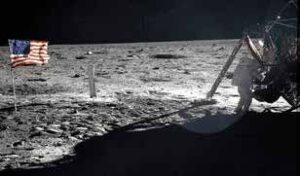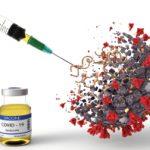 On July 20, 1969, at 10:56 p.m. EDT, American astronaut Neil Armstrong stepped off the lunar landing module, Eagle, and walked on the moon.1
On July 20, 1969, at 10:56 p.m. EDT, American astronaut Neil Armstrong stepped off the lunar landing module, Eagle, and walked on the moon.1
Or so they would have you believe.
For most, the basic facts are not in dispute: On May 25, 1961, President John F. Kennedy delivered a speech to a joint session of Congress on Urgent National Needs, in which he declared:2
[I] believe that this nation should commit itself to achieving the goal, before this decade is out, of landing a man on the moon and returning him safely to earth. No single space project in this period will be more impressive to mankind, or more important for the long-range exploration of space; and one will be so difficult or expensive to accomplish. … But in a very real sense, it will not be one man going to the moon—if we make this judgment affirmatively, it will be an entire nation. For all of us must work to put him there.
Eight years later, Neil Armstrong, Buzz Aldrin and Michael Collins entered Apollo 11. Twelve minutes after the rockets began to fire, they were in space, having left the Kennedy Space Center to enter Earth orbit. Three days after that, Apollo 11 was in orbit around the moon.
The astronauts entered the lunar module, Eagle, which Armstrong piloted to the Sea of Tranquility. At 4:17 p.m. EDT, with only 30 seconds of fuel to spare, Armstrong radioed, “Houston, Tranquility base here. The Eagle has landed.”3
At 10:56 p.m. EDT, Armstrong exited the lunar module, and announced, “That’s one small step for a man, and one giant leap for mankind.”4
Together with Aldrin, he planted an American flag. They also left behind a patch in honor of the Apollo 1 crew that never made it past launch and a plaque that read, “Here men from planet Earth first set foot upon the moon. July 1969 A.D. We came in peace for all mankind.”5
As President Kennedy said, Apollo 11 was not the story of three astronauts. It was the story of the 411,000 people who made the project possible.6 Kennedy’s speech had inspired legions to seek out NASA, specifically to help put a person on the moon, an event that was witnessed by 650 million people worldwide.7
Are there really people who think the moon landing never took place?
Moon Landing Deniers
The number of people who don’t believe in the moon landing is growing. In a 1999 Gallup poll, 6% believed that the moon landing was a hoax. In 2019, that number increased to 10%.8
Not surprisingly, older Americans, who watched as Walter Cronkite narrated humankind’s first steps on the moon, are the most likely to believe. Only 3% of those older than 54 years doubted the moon landing, vs. 18% of Americans between 18 and 34 years old.9
What evidence supports the theory that the moon landing was faked? Most non-believers point to the iconic photograph taken by Neil Armstrong. In the photo, Buzz Aldrin is standing in the shadow of the lunar module, against a pitch-black sky. Next to him is an American flag, flying majestically, and surrounded by the boot prints left by the astronauts.10
You see the problem, don’t you?
If they are really on the moon, why are there no stars in the photograph? If that’s really Buzz Aldrin, why can’t we see his face? The boot prints look like they were made in wet sand, but everyone knows that there is no water on the moon. And why does the lunar module cast a shadow to the right while the flagpole casts its shadow to the left? Clearly, the photograph was staged.
And then we get to the flag. In the photograph, the flag is unfurled, fluttering in a breeze. But of course, there are no breezes on the moon. If the photo wasn’t staged, what other explanation could there possibly be?
If you truly believe the moon landing was a hoax, then you will not be swayed by mere facts. That said, the facts are as follows: The visor of the space suit was coated with a thin layer of gold, to protect the astronauts from solar radiation, not to protect the identity of a stunt double.11 To prove the photograph was illuminated by the sun (and not by studio lights), the computer graphic chipmaker Nvidia created a three-dimensional model of the Apollo 11 landing site. With this model, the company was able to demonstrate that light bouncing off the surface of the moon kept us from seeing the stars. The same reflected light, bouncing off the irregular terrain and the astronauts’ space suits, which were coated with mirror-like Teflon, created the various shadows seen in the photo.12



